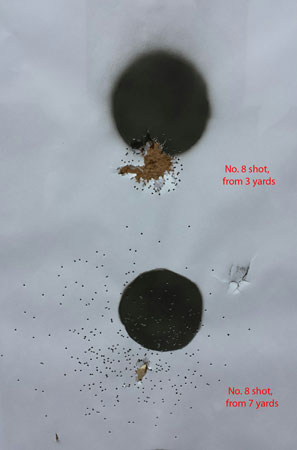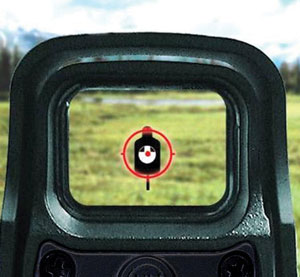You’ve probably heard someone — hopefully someone more knowledgeable than Joe Biden — dispense the advice that a shotgun is the ideal firearm for home defense. There are many sides to this “best gun” discussion, and most of them have some merit, but it can’t be denied that a shotgun can be incredibly effective for this purpose.
Does that mean you can just keep your duck-hunting shotgun by the bed and be done with it? Well, you certainly can. It will absolutely do the job in the right situation. But for maximum effectiveness in a home defense scenario, your duck gun falls a little short. Why?
For starters, the barrel is probably too long. The 12-gauge I duck hunt with has a 28-inch barrel. That’s ideal for swinging on fast-flying birds, but it’s more difficult than you think to maneuver a gun that length through hallways and around corners in your home. For that job, you want a shorter barrel — closer to 20 inches, maybe 18 (the shortest length the feds will allow).
In addition to that, your duck gun’s probably equipped with a simple bead or maybe a fiber-optic front sight. Again, that’s ideal for shooting flying objects in situations where you’re not supposed to even “see” the gun or the sights. But defensive situations are much different — you’re actually aiming the shotgun at a single target (at a time), and while the target might be moving, it will be at a considerably slower speed than a flushing pheasant or passing mallard. You’ll be aiming, not pointing and swinging.
 Too many people think of a shotgun as a spray-and-pray foolproof weapon, believing it’s impossible to miss because of the distribution of the shot’s pattern. Truth is, it’s incredibly easy to miss a target with a shotgun at home defense ranges, which are typically within 20 yards or less — usually much less. At a Ladies Shotgun training course I recently took at Gunsite Academy, the instructors had us shoot paper targets at 3, 7 and 15 yards with a 20-gauge load of No. 8 shot. At 3 yards, which isn’t as close-range as it sounds, that load shot almost a single hole, like a slug. At 7 yards, the pattern opened up some, but not as much as you think — certainly not wider than the size of a human’s center mass. One jerk of the trigger in the heat of an adrenaline dump and you’re way off target.
Too many people think of a shotgun as a spray-and-pray foolproof weapon, believing it’s impossible to miss because of the distribution of the shot’s pattern. Truth is, it’s incredibly easy to miss a target with a shotgun at home defense ranges, which are typically within 20 yards or less — usually much less. At a Ladies Shotgun training course I recently took at Gunsite Academy, the instructors had us shoot paper targets at 3, 7 and 15 yards with a 20-gauge load of No. 8 shot. At 3 yards, which isn’t as close-range as it sounds, that load shot almost a single hole, like a slug. At 7 yards, the pattern opened up some, but not as much as you think — certainly not wider than the size of a human’s center mass. One jerk of the trigger in the heat of an adrenaline dump and you’re way off target.
All that to say, you need an aiming system that works, that’s fast, and that’s as versatile as possible. A scope works, but you don’t need or want any magnification at these ranges. A red dot is a better option, and in our training course, we opted for EOTech holographic sights — in my opinion, the best solution available.
 A holographic sight has several advantages. It doesn’t require any eye relief at all, so it can be mounted as far forward or as far back on the gun as you like. The small housing keeps it from intruding into your peripheral vision. And perhaps most importantly, it’s incredibly quick because it doesn’t require perfect alignment — if you see the dot, the shot is going to go where the dot is, even if your eye (which acts as the rear sight) is not perfectly lined up with the reticle (the front sight).
A holographic sight has several advantages. It doesn’t require any eye relief at all, so it can be mounted as far forward or as far back on the gun as you like. The small housing keeps it from intruding into your peripheral vision. And perhaps most importantly, it’s incredibly quick because it doesn’t require perfect alignment — if you see the dot, the shot is going to go where the dot is, even if your eye (which acts as the rear sight) is not perfectly lined up with the reticle (the front sight).
For two days at Gunsite we shot Federal Premium No. 8s, No. 4s, buckshot and slugs out of our home defense-configured Mossberg 500s, with the holographic EOTech sight providing a perfect sight picture. The EOTech reticle is a red aiming dot surrounded by a red circle, which is ideal for getting you on target quickly without having to worry about lining anything up. When shooting with a holographic sight, your focus should be on the reticle, not on the target as it would be in wingshooting. The dot-within-a-circle reticle on the EOTech makes that easy and natural, and because it’s larger than just a single red dot, it’s incredibly fast to pick up and get on target. Keep both eyes open to maximize your peripheral vision.
What about load selection — birdshot, buckshot, slugs? That depends on your situation, your home and your neighborhood. Gunsite instructor Il Ling New likes birdshot around size No. 4. The 8s we patterned don’t offer enough penetration beyond a few yards to reliably stop a bad guy, especially if he’s wearing anything thicker than a T-shirt. Even No. 4 is certainly no guarantee, but there are overpenetration factors to consider. In my case, I live in a brick house in a subdivision on a 1/3-acre lot. I can stand in my bedroom doorway and look maybe 15 yards across an open living room, straight into the wall of my daughter’s bedroom. Any load that still carries lethal energy through a wall in the event of a clean miss is out of the question; certainly slugs are not an option. The issue of penetration has been studied and discussed online to the point of exhaustion, so I won’t go into it further here. After hearing Il Ling’s advice and patterning a wide variety of loads and slugs over a three-day training course, I’ve settled on a turkey load of No. 4s. Your situation might be completely different. Search “shotgun vs drywall” on YouTube and spend a few minutes watching videos to educate yourself on what’s safe and effective to use in your home.
Can you convert your old duck gun into a home defense gun? In most cases, yes. It’s a matter of changing the barrel and mounting an optic (hopefully your shotgun is drilled and tapped). This is easily done with a flexible system like Mossberg’s FLEX 500, which we used for the Gunsite course. The FLEX system allows you to change parts — barrels, stocks, recoil pads, forends — in just seconds using absolutely no tools. This is particularly useful because if you select an adjustable stock, every member of the family can use the same gun and have it fit them well. Don’t forget to mount a holographic sight like the EOTech, and practice with your home defense rig. Some dummy rounds will be helpful for practicing loading and speed reloading. You can get as elaborate as you like with tactical rails and lights and accessories, or keep it simple and have fewer things to worry about in the heat of the moment.
Incidentally, that setup — short barrel, holographic sight — is close to perfect for turkey hunting, too, if you like your guns to do double (or triple) duty.






